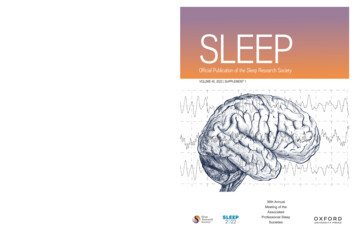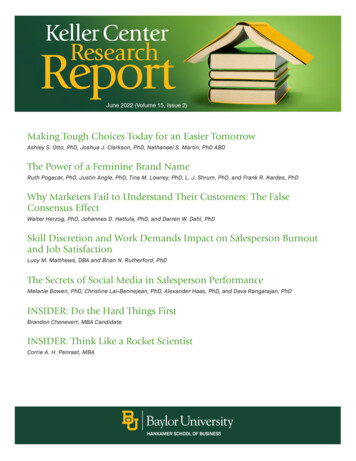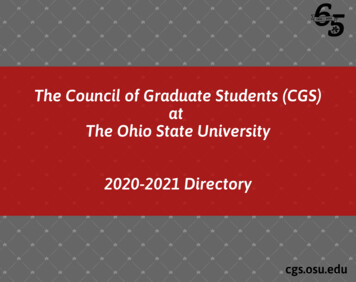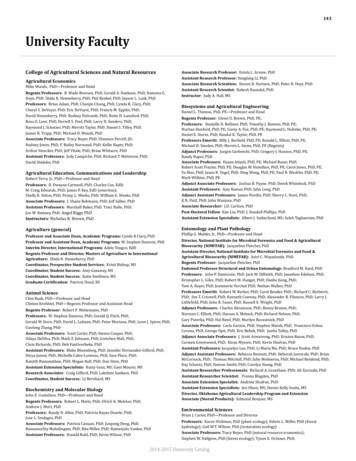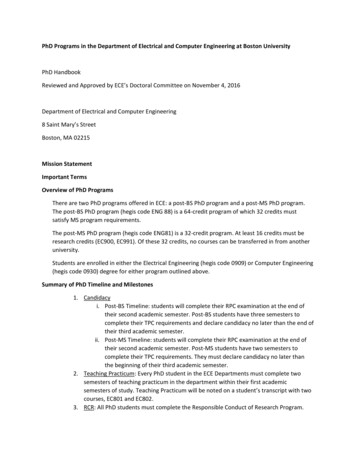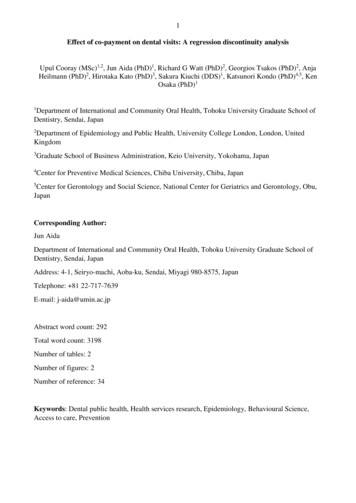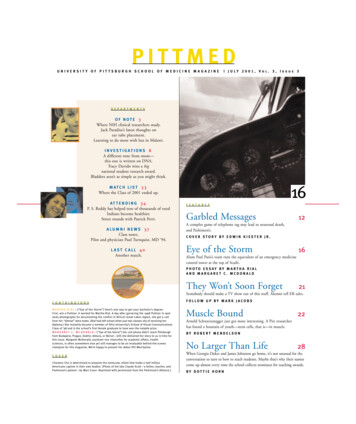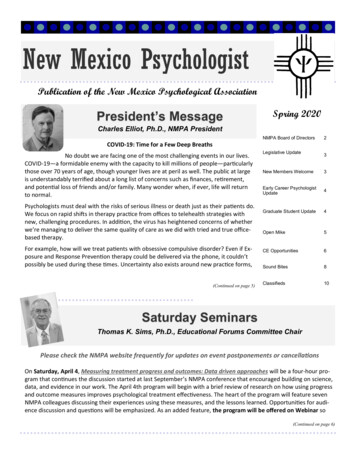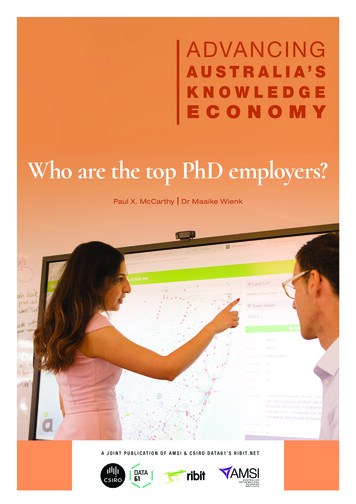
Transcription
ADVANCINGAU STR A LI A’SKNOWLEDGEECONOMYWho are the top PhD employers?Paul X. McCarthy Dr Maaike WienkA J O I N T P U B L I C AT I O N O F A M S I & C S I R O D ATA 6 1’ S R I B I T. N E T
ADVANCINGAUSTR ALIA’SKNOWLEDGEECONOMY WHOARETHETOPPhDEMPLOYERS?IntroductionFor many PhD graduates entering theemployment market with recent researchtraining under their belt, a career in researchand higher education would seem to be theobvious choice. After all, that is the kind ofwork they have been trained to do. However,with the steep rise in PhD graduations inrecent years, and growing demand withinthe private and public sectors for innovativecapability, universities are no longer theonly career option. Some evidence seemsto point to a problematic job market forPhD graduates and difficulties in securingemployment after graduation.1 However,there is significant demand in the privateand public sector for people with deepknowledge and sound research andanalytical skills. If there is a gap that needsbridging, it could be a lack of understandingon the part of employers outside academiaof the value of engaging a PhD scholar orgraduate to meet these needs.With the steep risein PhD graduationsand growing demandwithin the privateand public sectors forinnovative capability,universities are nolonger the maincareer optionIn this collaborative project between the Australian Mathematical SciencesInstitute (AMSI) and CSIRO Data61’s student‑employer matching platform,Ribit.net, we illuminate current engagement between industry and researchgraduates. We have investigated which sectors within the Australianworkforce employ PhD holders, and what the career ambitions of current PhDstudents are. Our focus is on PhD graduates already working, or having theambition to work outside of academia: What sectors are the most researchand innovation intensive and employ the most PhDs? Who are the top PhDrecruiters among Australian businesses? What, if any, are the differencesbetween PhD graduates from various fields of study?This analysis is a first step in a broader campaign to: Encourage Australian businesses (big and small) to expand theircapability, innovative capability and global competitiveness throughhiring PhD scholars and graduates; Promote further engagement between industry and the research sectorin Australia in a bid to increase our productivity in a fast‑changing world. 2019 The Universit y of Melbourne on behalf of the Australian Mathematical Sciences InstituteA JOINT PUBLICATION OF A MSI & C SIRO DATA61’S RIBIT.NE T PAGE 2 OF 20
ADVANCINGAUSTR ALIA’SKNOWLEDGEECONOMY WHOARETHETOPPhDEMPLOYERS?Key findingsAnnual PhD completionshave more than doubledin the last two decadesThere are many morePhD graduates thanacademic jobs availablePhD graduates areincreasingly findingjobs outside academiaAs with most other OECD countries,There are not enough jobs for all PhDA growing percentage of PhD graduatesthe number of PhD completions ingraduates in academia. The total numberare finding employment in businesses,Australia has grown dramatically,of PhD graduates has outnumbered thegovernment and the non‑profit sector.from under 4,000 per annum in thenumber of academic jobs available in19 out of the 20 largest ASX listedyear 2000, to around 10,000 perAustralia since the mid‑1990s and thecompanies now have PhD graduatesannum today.gap has widened ever since.among their senior executive teams.51% 49%About 51% of PhD studentshope to enter business orthe public sectorTop business PhDemployers are finance andresources & energy sectorsJust over half of current Australian PhD studentsThe Australian business sectors that employ the(51 percent) responding to our national surveymost PhDs are banking, finance and insurance,hope to leave academia and work in business orfollowed by mining, oil and energy and thethe public sector once they graduate.medical and pharmaceutical industry.Public and privatehealth & medical sectorsemploy the most PhDsAustralia’s existinggrowth sectors leadPhD employmentInnovation is key tofuture opportunityIn the public sector, the main area of PhDMany PhD employers are aligned with theThere are significant opportunities aheademployment is hospitals and health care,nation's growth sectors related to medicine,for PhDs to work with young, globalwhile in the business sector the medicalpharmaceuticals, advanced manufacturing,startups and innovative Australianand pharmaceutical industry ranks third.mining and finance as well as emerginghigh‑growth employers.Together these sectors employ the mostindustries such as environmental servicesPhD degree holders outside of academia.and media technology and services.A JOINT PUBLICATION OF A MSI & C SIRO DATA61’S RIBIT.NE T PAGE 3 OF 20
ADVANCINGAUSTR ALIA’SKNOWLEDGEECONOMY WHOARETHETOPPhDEMPLOYERS?Project approach10 million This project reports from a range of databe aggregated at a country wide scale. Forsources. In the section “PhD graduationeach of the 147 separate industries listedin numbers”, we bring together somein LinkedIn, we recorded the total numbernational and international statistics onof employees with a PhD as well as thePhD graduations. “The value of researchtop 15 employers of PhDs in that industry.training” section describes some of theCounts of PhDs were re-tallied by employer.literature and data on the value of a PhDThis is to account for the fact that differentdegree to students themselves, andemployees from the same employer mightthe skills PhD graduates bring to theself‑classify as belonging to differentworkforce. Our project adds to the existingindustries (they might choose either banking,knowledge with a new national survey ofor finance for instance). Employees workingPhD students at Australian universitiesat universities sometimes self‑classify asas well as analysis of the employmentbelonging to an industry aligned to theirpatterns of PhD graduates in Australia asfield of research or work rather than withrevealed through LinkedIn profiles.“research” or “higher education”.LinkedIn is a global professionalAccording to the 2016 ABS census, 50 pernetworking platform, which was launchedcent of the employed doctorate holders inin 2003 and has since then amassed2016 were working in tertiary education andmore than 600 million users worldwide. Inresearch.4 From our analysis of LinkedIn, weAustralia alone, 10 million members out offound that about 52 per cent of people ina total workforce of 12.6 million people 2,Australia on LinkedIn and with PhD degreeshad a profile on LinkedIn as of Octoberwork in the research and higher educationpreferred sector of employment. A total of2018. It is therefore a valuable source ofsector. The remaining 48 per cent work446 responses were received from PhDdata on indicative trends in talent andin business (around 23 per cent) and thecandidates from 32 universities in all statesqualifications on a national level.public sector comprising government andaround Australia as well as a handful ofLinkedIn membersin Australia5This representsaround out ofworking Australians10870,000AroundAustralians withPhD qualificationson LinkedInnon‑government organisations (around 24expats studying at overseas universities. AllWhere do Australia’sPhD graduates work?per cent). These ratios were cross‑validateddisciplines including business, science, artswith a random sample of 167 PhD graduatesand health were represented in the surveyUsing LinkedIn, we completed a tally of allin Australia that were individually handwith students working in over 100 differentemployers in Australia with PhD-qualifiedcoded as either working in academia,fields from accounting to zoology.employees, classified by industry. A totalindustry or public/health sector and thesample of 67,826 Australians indicated inresults were consistent, with 51 per cent ofStudents were also asked to name theirtheir profile they have a PhD qualification.the sample working in academia.top two “ideal” employers. Many studentsAccording to the 2016 ABS census, thereBy summing up the PhD counts of eachinstead preferring to give a broad indicationwere 135,277 doctorate degree holders inemployer in the top 15 in each industryof the sector and kind of employment theyAustralia in 2016, of which 103,016 werewe can provide a good indication of bothare interested in.employed at the time.3 The 67,826 PhDthe main areas in the public and businessholders with LinkedIn profiles thereforesector that employ PhD graduates, as wellCase historiescover at least about half of all peopleas a list of the top employers in each sector.Throughout this report you will find somestopped short of specifying companies,in Australia with a research doctorate.examples of PhD research expertise appliedWhere do current PhDstudents want to work?within industry. These case studies illustrateinvestigate where PhD graduates tend tofind employment.The second part of the project — examiningorganisations outside the academic sector,the career ambitions of current PhDand the value they have added to theseEveryone with a LinkedIn profile maystudents — was carried out through aorganisations by bringing their researchchoose one — and only one — industry innational survey of PhD students. The surveytalents to short term projects. The sourcewhich they work. PhD cohorts by industryasked students to nominate their field ofof these stories is the APR.Intern (formerlyare therefore mutually exclusive and canresearch, their place of study and theirAMSI Intern) program.This is a solid basis on which to furtherA JOINT PUBLICATION OF A MSI & C SIRO DATA61’S RIBIT.NE T the appetite of PhD students to engage withPAGE 4 OF 20
ADVANCINGAUSTR ALIA’SKNOWLEDGEECONOMY WHOTop 50 PhD Employers inbusiness (500 staff)BA NK ING, FIN A NCIA LSERVICE S & INSUR A NCEAustralia and New Zealand BankCommonwealth Bank of AustraliaMacquarieNational Australia BankSuncorpWestpacCOMPUTER SOFTWARE &INFORMATION TECHNOLOGYAmazon Web ureconMINING, OIL& ENERGYAlcoa CorporationBHPChevronOrigin EnergyRio TintoShellWoodside EnergyWorleyParsonsMANAGEMENT CONSULTING& ACCOUNTINGBoston Consulting GroupDeloitteEYKPMGMcKinsey & CompanyPwCOTHER INDUSTRIE S &SERVICE SL AW & LEG A L SERVICE SAustralian Broadcasting “My PhD taught me todevelop myself and mythoughts with muchgreater rigour. It alsocreated a life-long curiosityto understand and acquireas much knowledge aspossible. My thesis touchedmuch of the scientificand engineering basis ofthe mining, oil and gasindustries. This has servedme well in a corporateworld struggling withcultural and technologicaltransformation. It hashelped me with critical,information-basedhigh-quality decisionsthroughout my career –and made me into theleader I think I am today.”Davies Collison CaveFB RiceTELECOMMUNICATIONSMEDICA L &PH A RM ACEU TICA edSanofiSeqirusNBN Co.Telstra CorporationU TILITIE SDr Andrew MackenzieCEO, BHPAustralian Energy Market OperatorMelbourne WaterSydney WaterWestern PowerA JOINT PUBLICATION OF A MSI & C SIRO DATA61’S RIBIT.NE T PhD in Organic ChemistryPAGE 5 OF 20
ADVANCINGAUSTR ALIA’SKNOWLEDGEECONOMY WHOAREFigure 1 Trends in PhD completions and academic workforce inAustralia 1948–2018 (Per annum and cumulative) 6THETOPPhDEMPLOYERS?more modest growth in the academicworkforce reveals how sometime in the2000001990s the academic workforce becameunable to absorb the number of PhD150000graduates. Since that time, an everincreasing proportion of PhD graduates100000has had to find employment elsewhere.50000According to 2016 census data, the top019401960PhD Completions Per annum1980Cumulative PhD's Granted2000Domestic PhD's in Workforce2020Academic staffCumulative estimate adjusted for overseas PhD students moving back to their home country after graduating, and for life expectationFigure 2 Proportion of PhD graduations in the OECD (per 1,000 people of working age) 7industry destinations of PhD graduateswere tertiary education (41.9 per cent),followed by professional, scientific andtechnical services (13 per cent), medicaland other health care services (7.1 per cent)and public administration (6.2 per cent).11However, these figures do not tell us how30the PhD graduates are divided over the25private, public and academic sector. They20also do not give us an idea of the possible15differences between PhD graduates from10different fields of study. These are areas5where our investigation of LinkedIn data0gives fresh insights.Swit zerlaU n S l ov ndi te end S iataS w teseG e denrmaF in nyla nUnite I dd K sr ain elA u gdost mraNo l i arD waN e e nm yw aZe rkalanOE dCAu DstrI r e iala nFr danC a cenadKo areaSpB a inN e elgt h iumerla nG r dseecPo ela ndRuItssia n T alyF e ur kd e eyration35Female PhD graduatesMale PhD graduatesHow does Australiacompare internationally?The Australian PhD graduation rate (1.17 perBackgroundPhD graduation in numberscent of the working population) is slightlyover the OECD average of 0.99 per cent ofthe working population. However, it is lowercompared to the USA (about 1.78 per cent),Germany (1.38 per cent) and the UnitedAccording to ABS Census data, there weretransformation that has taken place, away116,096 residents with a PhD degree infrom the traditional destiny of the aspiring2011, and 135,277 in 2016 – an increaseacademic scholar: the university. The PhDPhD graduation rates are rising across theof more than 19,000 over a period of fivecompletions per annum (the blue line) showOECD: new doctorate graduations grewyears. The number of PhD graduationsa steady increase, in particular from thefrom 158,000 in 2000 to 247,000 in 2012.has been steadily rising for a number of1980s onwards. The size of the academicThey have also grown as a proportion of allyears. Since 2000 the PhD graduation rateworkforce (the yellow line) also shows andegree completions. The OECD averageincreased from about 1.3 per cent to 2 perupward trend over a long period of time.was 1 per cent in 2000, growing to aboutcent of all graduations in 2012. In absoluteThe purple line represents a cumulative1.65 per cent in 2012.13numbers, the number of people graduatingcount of PhDs granted annually, and thewith a doctorate in research has more thangreen line an estimate of the growth ofData from the OECD reveals that PhDdoubled in this century, from 3,933 in 2001domestic PhD holders in the Australianemployment by sector varies considerably.to 9,054 in 2017.workforce. Note that this cumulativeIn countries such as Poland and Portugalestimate is adjusted for overseas PhDthe overwhelming majority of graduatesFigure 1 combines long-term trends in PhDstudents moving back to their home countrywork in the higher education sector.completions, cumulative estimates of theafter graduating, and for life expectation.However, in other countries, such as The89number of PhD holders in the community,Kingdom (1.21 per cent).12Netherlands, Belgium, Denmark, the Unitedand trends in academic staff numbersThe combination of the long-term trends,Kingdom and the United States, more thanover the last 50 years.10 It provides ain particular the exponential growth of thehalf of doctorate holders work outside ofsimplified but revealing account of thePhD workforce and the steady, but muchacademia — in business or government.14A JOINT PUBLICATION OF A MSI & C SIRO DATA61’S RIBIT.NE T PAGE 6 OF 20
ADVANCINGAUSTR ALIA’SKNOWLEDGEECONOMY WHOAREFigure 3 Which sectors employ PhD graduates by percentage (OECD 2009) 16100.087.575.062.550.037.525.012.5Higher education & researchBusinessGovernmentJapang ndomFranceKiditeUnPolanCh Por din t ues gaeTa lipeTu irkeyMRualssia R om t anFe ande iaraL i tionthuanC r iaoaB u tialgaH u riangaryLatvSl iaoveniUn I ce aite landdStatesSpaB e inlgiuDe mN e nmth arkerlands0.0Other or unknownAustralian data by sector has not been available to the OECD for this graphFigure 4 A growing share of PhD graduates in the UnitedStates are being employed outside academia 176054.3%52.6%THETOPPhDEMPLOYERS?“The promotion of anindependence of thoughtand an understanding ofthe value of persistence thatcomes from doing a PhDhas helped meaningfullyin my business career, eventhough that career has beenin an industry differentfrom my original %200520062007200820092010Higher education & sDr Brett CairnsCEO, Magellan Financial GroupPhD in Chemical EngineeringFigure 5 Most United States STEM PhD graduates work inindustry, humanities graduates stay in academia ineeringBusinessPhysical sciences Mathematics && earth sciences computer sciencesGovernmentNonprofitLife sciencesPsychology &social sciencesOther or unknown6%Humanities & artsHigher education & researchAustralian data by sector has not beenIn the United States, PhD graduatesfrom various areas of study. Where mostavailable to the OECD.working outside academia have started topsychologists and social scientists with aoutnumber those remaining in the academicPhD overwhelmingly tend to stay on in anA 2017 survey by the European Sciencesector in the last decade. Data showacademic job, most engineers, computerFoundation among “early career”that the percentages of PhD graduatesscientists, and other scientists in science,doctorate holders at nine Europeanemployed in research and higher educationtechnology, engineering and mathematicsorganisations in The Netherlands,and the public sector have been in steady(STEM) areas move on to jobs in industry.Germany, Romania, Croatia, Luxembourg,decline. Fewer than half of all United StatesAustria and France found that 62 perPhD graduates now work at universities.cent of respondents worked in academia,The analysis of the LinkedIn data shedssome light on the career destinationsbut that 39 per cent of those workingThe data from the United States alsoof Australian PhD graduates – includingin a research role were planning toprovides a glimpse of the differences indifferences between doctorate holderschange to a non-research career.15career destinations between PhD holderscoming from different areas of study.A JOINT PUBLICATION OF A MSI & C SIRO DATA61’S RIBIT.NE T PAGE 7 OF 20
ADVANCINGAUSTR ALIA’SKNOWLEDGEECONOMY WHOARETHETOPPhDEMPLOYERS?Research outcomesPhD employers in Australia:Summary of the project resultsWhere do our PhDgraduates work?by mining, oil and energy. The medical andOur exploration of LinkedIn data showssignificant numbers of PhD graduates.pharmaceutical industry also employ verythat a considerable proportion — 4 8 percent — of doctorate holders are employedThe index of top 50 PhD employers inin the private and public sectors. Whilethe business sector contains some of thethis proportion is not quite as high as inlargest companies in Australia, such asthe United states or some other countries,the “Big Four” banks and large miningit represents a substantial number of PhDentities. Many are Australian branches ofgraduates. Based on the reported yearsmultinational companies with thousandsof experience of employees on LinkedIn,of employees both here and overseas.we estimate that over the last ten years,The LinkedIn data also shows that theon average more than 2,500 doctorateoverwhelming majority of PhD graduatesholders per year have entered the public(more than 70 per cent) work for very largeand private sectors. Given the growth ofemployers (including universities) thatPhD graduations, this number will likelyemploy more than 500 staff. This leavesincrease every year. For example, basedjust under a third of PhD graduates workingon the 2017 number of domestic PhDfor small (1–19), medium (20–199) or largergraduates (5,525)19, as many as 2,652organisations with 200–500 staff.new graduates entering the job marketin 2017/2018 might have ended up inIn the public sector, various levels of statebusiness, public or non‑profit sectors.and federal government dominate as PhDemployers. Within federal governmentBusiness sectors thatattract PhD graduatesspecialist, knowledge‑intensive agenciesIn the private sector, certain industriesGeoscience Australia and the Bureau ofstand out for engaging and employingMeteorology have a high percentage of PhDresearch‑trained recruits. Topping thegraduates. 20 The hospital and health careareas of employment are the banking,sector is likewise a prominent employerfinance and insurance industries, followedof researchers. In fact, combined with itssuch as the Australian Bureau of Statistics,“I work in high tech,financial servicesand capital marketsenvironments, whichare predominantly maleoriented. As a womanin leadership, having aPhD has enabled me todemonstrate immediatecredibility in thesesectors. It has stood mein excellent stead withregard to analysing andsynthesising disparateinformation in order tomake predictions aboutemerging technology trends.The PhD is powerfullyuseful, but well beyond theway I originally thought.”Figure 6 Business Top 100: The main industries employing PhD graduates in Australia 21Medical & pharmaceuticalLaw & legalservicesMining, oil & energyCivilengineeringTelecommunicationsBanking, financial services & insuranceManagementconsulting &accountingDr Catriona WallaceCEO and founder, Flamingo AIPhD in Organisational BehaviorHuman Technology InteractionComputer software &information technologyA JOINT PUBLICATION OF A MSI & C SIRO DATA61’S RIBIT.NE T PAGE 8 OF 20
ADVANCINGAUSTR ALIA’SKNOWLEDGEECONOMY WHOFigure 7 Spread of PhD employment by size of employer 227.6%19.6%6.7%Very large4.6%(500 employees)33%EMPLOYERS?A PhD internship with51-200CSL has influencedthe way the 5001-10,000SMEs & large28.3%THEFostering long‑termcollaboration betweenresearch & industry10,000 5.9%14.4%AREtherapeutics company1-10identifies new drugs andSelf-employedimproves treatments fora range of conditions. DrMilica Ng first started atFigure 8 Government, health, defence and not-for-profitCSL in 2013 as a PhDtop 100: main sectors employing PhD graduates 23intern, after catching theeye of CSL with her skillset across mathematics, computing and engineering.From intern to department head in five years, Milicanow leads the Data Science team at CSL and istaking on her own PhD interns, cultivating her teamState governmentDefence & spaceNonprofit & charityHospital & health careReligious Museums &inst.institutionsFederal governmentand supporting the company’s capacity to developand deliver innovative biotherapies that save lives,and help people with life‑threatening medicalconditions live full lives.Milica and her team are working alongsideFigure 9 Australian PhD employment by sector and field of study 24biomedical researchers leveraging bioinformatics,biostatistics, high‑throughput image analytics,100systems modelling and artificial intelligence80approaches to support identification of newtherapeutic targets and confirm effectiveness6040of existing therapies. Milica has thrived in this52%46%ever‑changing landscape, driven by the challenge35%20023%EngineeringComputer ScienceBusiness & governmentMathematicsAnthropology & sociologyHigher education & researchcounterpart in the private sector, the medical and pharmaceutical industry,the combined public and private medical and health‑related industries are themost PhD‑heavy all around.In light of the substantial differences in career outcomes of PhD graduatesfrom different areas of study in the United States (see “PhD graduation innumbers” in this report), we were not surprised to find similar results inAustralia. In Australia for example, we can see from our analysis of LinkedInof rapidly advancing research technologies and theneed to work with increasing volumes of data.“I definitely enjoy the dynamicnature of the field. It is exciting tosee the role of mathematical andother quantitative sciences evolve inmedical and biological research withthe rapid development of measuringplatforms and technologies.”Dr Milica Ng, CSL Head of Data Sciencedata that sociologists and anthropologists overwhelmingly remain in academicjobs. On the other hand, the majority of engineers end up moving out ofresearch and higher education into industry.A JOINT PUBLICATION OF A MSI & C SIRO DATA61’S RIBIT.NE T Now with experience on the other side of the fence, Milicais an advocate for on‑going engagement of PhD interns.PAGE 9 OF 20
ADVANCINGAUSTR ALIA’SECONOMY WHOKNOWLEDGEAREResearch outcomesFigure 10: Spread of PhD employment in Australian businesses with less than 500 staff 27Mining equipment, services & technology 3%Advanced manufacturing 7%Media services & technology 11%Business & propertyservices 14%Legal services &technology 7%THETOPPhDEMPLOYERS?“The PhD has taught me howto finish what I started andtaught me persistence, which Iuse on a daily basis in my job”Consumer goods 1%Cybersecurity 1%Defence 2%Medical services &technology 19%Energy &resources 9%Engineering & construction 9%Food & agricultural technology 2%Financial services & technology 3%Environmental goods & services 12%Dr Silvia PfeifferCEO & Co-Founder, CoviuPhD in Computer SciencePhD employment in companieswith less than 500 staffservices, media technology and services,mining and many other industries withas well as small and medium enterprises inmobile safety inspection software.Employment of PhD degree holdersengineering and construction and businessis not limited to Australia’s largestand property services.employers. Almost a third of PhD holdersNote also that many of the companieswe have listed are serving globalare employed in organisations withMany of the companies in this list arecustomers — in media technology andless than 500 staff. Our exploration ofdeveloping software products to transformservices for example, Appen is providingPhD employers in the business sectortheir industries. For example, Downvoice technology infrastructure services towith under 500 employees reveals anUnder Geosolutions’ software is usedtechnology companies around the world;interesting cohort of innovative and highby the oil and gas industry worldwide;Melbourne‑based Redbubble runs one ofgrowth companies across a range ofCanva — valued at over 1 billion lastthe world’s largest online marketplacesindustries. Many of these companiesyear — is transforming graphic designfor independent designers; Rokt, based inare Australian-owned but have aworldwide via its online design software,Sydney, is now one of the world’s leadingglobal focus — together the top 100 ofand SafetyCulture is providing airlines,marketing technology companies.these employers employ over 500 PhDgraduates. This gives an indication ofthe innovative drive of the industries inwhich these businesses operate andtheir openness to adding analytical andresearch capacity to their business.Interestingly, many of the sectors in whichthese companies operate align with theexisting Industry Growth Centres whichhave been established as an initiative ofthe Department of Industry, Innovation andScience in six industry sectors: AdvancedManufacturing, Cyber Security, Food andAgribusiness, Medical Technologies andPharmaceuticals and Oil, Gas and EnergyResources. 25 However, some other sectorsare also revealed as areas of innovation,such as environmental goods andThere is significantdemand in theprivate and publicsector for people withdeep knowledge andsound research &analytical skillsA JOINT PUBLICATION OF A MSI & C SIRO DATA61’S RIBIT.NE T PAGE 10 OF 20
ADVANCINGAUSTR ALIA’SKNOWLEDGEECONOMY WHOAREFigure 11: Where do Australia’s current PhD students want to work? 28605048.7%403017.5%2013.7%100Universityor researchinstituteLarge globalor nationalenterpriseGovernmentor publicservice9.0%6.7%Startupor SME4.5%Not-for-profit researchor communityorganisationOther/unsureFigure 12: Career aspirations of Australian PhD students by discipline 29100806064%61%56%4033%200EngineeringComputer ScienceBusiness & governmentMathematicsHigher education & researchAnthropology & SociologyTHETOPPhDEMPLOYERS?“A PhD is an endeavourin itself and curiousminds embarking on thejourney of getting one havecertainly gone through atruly transformationalexperience. Planning andexecuting a project as largeas a doctorate requiresskills similar to the onesthat modern industryneeds: innovation, agility,desire to be relevant andkeep up with state-of-theart if not to define it!”Other or UnknownWhere do our PhD studentswant to work?& sociology with the actual employmentThe survey among PhD students revealsLinkedIn, we see similarities between thethat many recognise and see the value intwo. According to survey responses, thepursuing careers outside of academia.participating students in STEM-relatedJust over half of survey respondentsareas tended to have the highest interestaspire to work in business, governmentin working outside academia. Given theCEO & Co-Founder, Flurosatand related sectors. For 26.5 per cent oflow number of responses included in thisPhD in Aeronautical Engineeringstudents their ideal employment is in agraph (from 33 engineering, 42 computerprivate sector enterprise, while 13.7 perscience, 16 mathematical sciences andcent prefer to work for government and 6.76 anthropology and sociology studentsper cent in the not‑for‑profit sector. Theserespectively) we cannot draw any firmresults also align with the results from aconclusions. However, the similaritybiannual survey among doctoral studentsbetween career aspirations and careerperformed by Nature. In the latest Natureoutcomes does pose some interestingsurvey conducted in 2016 among 5,700questions that fall outside the scope ofdoctoral students worldwide, 22 per centthis report: How do career aspirations andof students preferred to work in industry, 9outcomes influence each other? Are theseper cent in a medical profession, and 9 perresults an indication that PhD studentscent in government.wi
ADVANCING AUSTRALIA'S KNOWLEDGE ECONOMY WH AR H OP Ph D MPLOYERS? A JOINT PUBLICATION OF AMSI & CSIRO DATA61'S RIBIT.NET PAGE 6 OF 20 Figure 1 Trends in PhD completions and academic workforce in Australia 1948-2018 (Per annum and cumulative)6 0 50000 100000 150000 200000 1940 1960 1980 2000 2020


